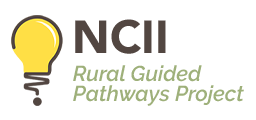Rural Pathways is the first time community partners are deeply embedded in pathways implementation. In prior pathways projects, institutions were asked to involve outside organizations in work on discrete topics, such as dual enrollment. In this project, regional partners are an integral part of each college’s team. The value of involving external stakeholders in pathways work — and giving them specific roles and responsibilities — is amplified in rural settings, where students’ education, residents’ economic mobility, and the regional economy are so closely intertwined.
Each college has designated five or six community partners that are committed allies in enhancing regional economic opportunity. These community partners are participating in the project for its duration, including attending Institutes (when content is relevant) and all in-person coaching visits.
In Phase 1, rural partners included high school superintendents, principals, and teachers; elected officials; CEOs of chambers of commerce; CEOs of hospital systems; and leaders of local workforce initiatives. Including community partners in Rural Pathways Institutes led to many breakthrough moments for both colleges and their partners.
Bringing community partners into the work from the outset changed the way Phase 1 colleges thought about their work — and changed the way community partners thought about the colleges. As a result, colleges and their partners forged deeper connections that benefited both students and communities.
